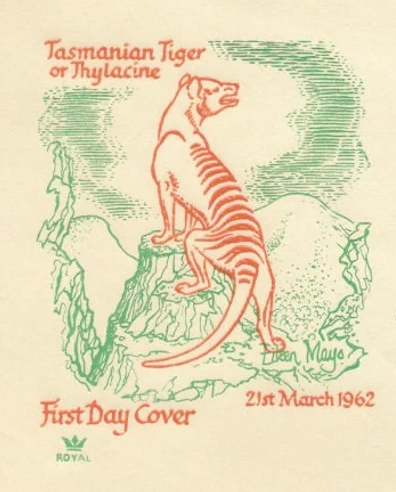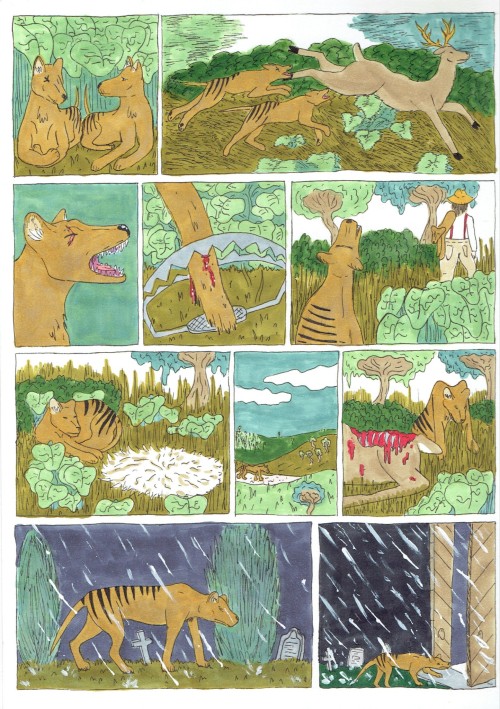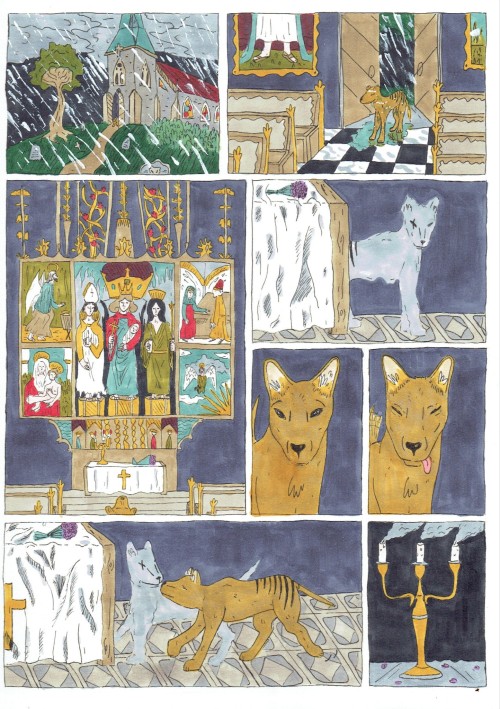
Collection of media revolving around the Thylacine
149 posts
Latest Posts by moonlight-wolf-archive - Page 3
Wait wait!!! The skin doesn't quite match up and we really need more photos of the specimen to match it with Benjamin!
The article is confusing I'll admit 😭
THEY FOUND BENJAMIN’S REMAINS!?!?!??!?!?

Preserved adult thylacines
Happy New Years! Here's this lil edit

There's a lot of angles of the skin we're missing
But I know a Thylacine's stripes are often compared to finger prints
(these are just observations)


1. Highlighted: branches of Benjamin's stripes where they connect to each other within the fur pattern.
Most are connected visibly on the photograph, while the skin only has one major visible branch.
We have witnessed museum specimens losing coloration before so that could be a theory as why the pelt is different if it is Benjamin.
2. Next is these two marks that I can't tell if their stripes or scars that Benjamin had. I don't know if the skin is cut where those marks would be visible or not.
Again just observations ^^

BRUH????
Hey y'all, I'm having the same thoughts
Here's some more images of Benjamin compared to the pelt



Do with that what you will
Also paddle is very much confusing me
The thylacine museum has a good section talking about Benjamin's sex as well.

BRUH????

tiger time

Illustrated Sketches of Natural History: Consisting of Descriptions and Engravings of Animals. Second Series. 1864.
Internet Archive
This is an awesome book
I definitely recommend it
Sorry if you’ve already said, but what’s the book you’ve been reading about thylacines?




Feel in my bones just what the future has in store
For species remembrance day
thylacines made good pets?? ;_; they do look like they'd feel soft and glossy to the touch. I'm obsessed with tassie devils, myself, but I'm resigned that they may go extinct before I can travel far enough to see them. I wish I could pet one.
They were obviously not domesticated to the level of having domestication syndrome features (not that I'm sure a marsupial animal *would*), but there are historical records of Tasmanians who kept them as pets, including both white settlers and indigenous people.
Thylacines were somewhat prone to capture myopathy (a stress reaction that causes some animals to die if trapped/captured) and sometimes died after capture, but many did not. If the animals were treated kindly they would generally respond well to attempts to tame them, and this was even more true of orphaned baby thylacines that were raised by humans. There are several stories of people who tamed thylacines very shortly after capture. One such thylacine was let go when she went into season and became restless, and she later introduced her pups to the man she had lived with.
Indigenous people were recorded as having kept them. One indigenous informant stated that they called them "stripey dogs" when they spoke English.
One of my favourite stories was of a white settler family had a large house and kept their thylacine on an extremely long chain in the front so that she could act as a sort of watchdog. This thylacine would watch over the children playing and did not react violently to them even if she was accidentally hit by a ball (she knew that this was an accident) and would give warning of anyone approaching.
The likely reason that thylacines did not become popular household companions was the hate campaign that sprung up around them, stating that they were sheep killers. Once that got to be a big issue and bounties were offered for killing them, people who were taming and raising the animals frequently found them killed, and they gave up on it.
Many of these stories are in Robert Paddle's book, which is an academic study but is extremely readable.

A pic of a taxidermy specimen of a Thylacine I took at the Gallery of evolution in Paris (I can’t help but cry everytime I think about this species)
(Personnal pic, please reblog, do not use or repost. Thanks!)

hypothetical abundism

another one

Charles R. Knight (1874-1953), Tasmanian Wolf and Cubs

From 50 Facts About Animals by Ron B. Taylor, published in 1983.
Dobsegna: in some parts of Papua New Guinea
I've also heard moonlight wolf (hence the blog name lol) that's uncommonly used.
What’s in a name?
Just for fun, I thought I’d compile a list of names for the thylacine in various languages.
Scientific: Thylacinus cynocephalus (lit. ‘dog-headed pouched one’); formerly Didelphis cynocephala (lit. ‘dog-headed opossum’) [x]
English: Thylacine, Tasmanian tiger, Tasmanian wolf, zebra wolf, marsupial wolf - Uncommon/old names: Zebra opossum, dog-faced dasyurus, native hyena, native tyger
Aboriginal: Coorinna, loarinna, laoonana, lagunta [x]
Spanish: Tilacino
German: Beutelwolf (lit. ‘bag wolf’)
French: Loup marsupial (lit. ‘marsupial wolf’)
Japanese: フクロオオカミ (fukuro-ookami, lit. ‘bag wolf’)
Swedish: Pungvarg [thanks bigfishboss]
Finnish: Pussihukka
Do you know any others?
This thylacine footage was recently rediscovered by researchers Gareth Linnard, Branden Holmes and Mike Williams on March 4, 2020.
Originally filmed by the Bester family c. 1933-1936, the 9.5mm black and white film includes 7 seconds of a captive thylacine in its enclosure at the Beaumaris Zoo.
Such a rare and amazing find!

Here’s a nice thylacine photograph I personally hadn’t seen before. From Eric Guiler’s book “Tasmanian Tiger: A Lesson to be Learnt.”
Photo caption in the book states that it’s a male at the Beaumaris Zoo.

“Museum staff were excited last week when they came across our mounted thylacine, or Tasmanian tiger (Thylacinus cynocephalus), specimen in a storeroom.”
Posted by Canterbury Museum on Facebook, April 13th 2019.





This is an adult male thylacine taxidermy from the Academy of Natural Sciences in Philadelphia. The most striking aspect of this mount is the little fangs - they may not be anatomically correct, but they’re pretty cute and give him a unique look :)
Unfortunately there is no information about where this specimen came from, the date it was collected or who donated it to the museum.
The mount is in fair to poor condition, with significant damage on the ears, belly, medial aspects of the legs, and near the base of the tail. The white band was placed around the belly in an effort to prevent the skin from cracking further. I did my best to show only his good side, but he’s in need of some serious restorative work. It’s a shame because his facial expression, pose and color are all quite good.
Eternal thanks to @diplotomodon for alerting me to the existence of this specimen!
(My main blog, @sixth-extinction is listed on the images.)

Animals in Danger. The 1974 Childcraft Annual.
any pics of tasmanian tigers? thank u,,, 🤲



1.) Animals of the Past. Written by Andrew Sortwell. 1980.
2.) via
3.) The wildlife of Australia and New Zealand. Illustrated by George Frederick Mason. 1967.

Mick Loates (b. 1947)
Beutelwolf :D

Erklär mir die Tiere. Written by Hans Peter Thiel. Illustrated by Fritz Köhler and Hildegard Huber. 1974.

Model of thylacine with mouth agape, displayed at the Kitakyushu Museum of Natural History and Human History in Fukuoka, Japan.
Via @hakubutu on Twitter.


Me and the dog, we die together!




Thylacine

Return to dust and stars.
Watercolor and color pencil.
